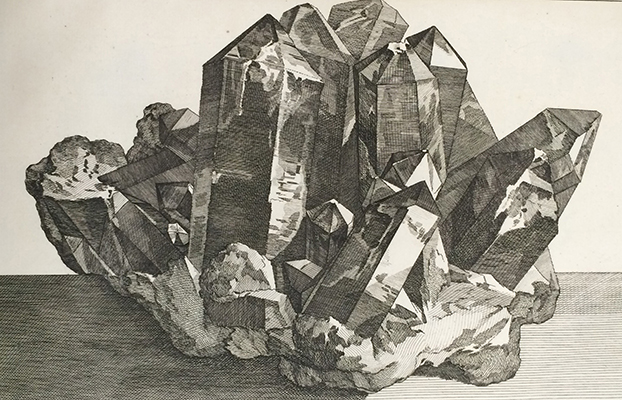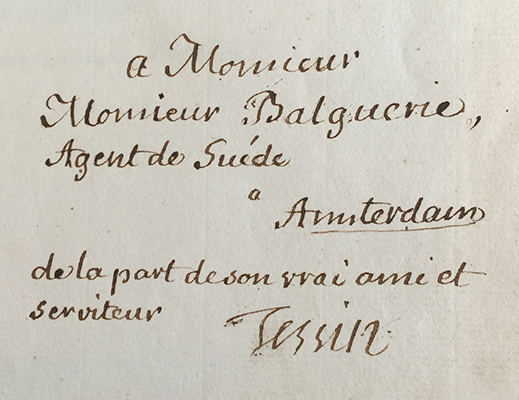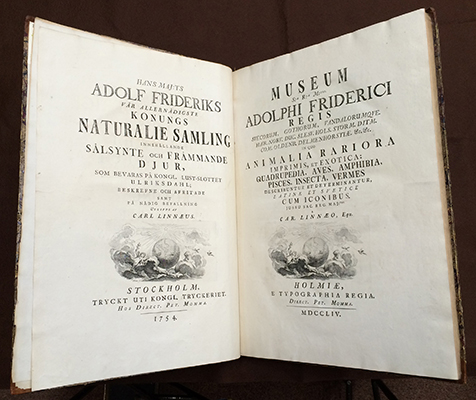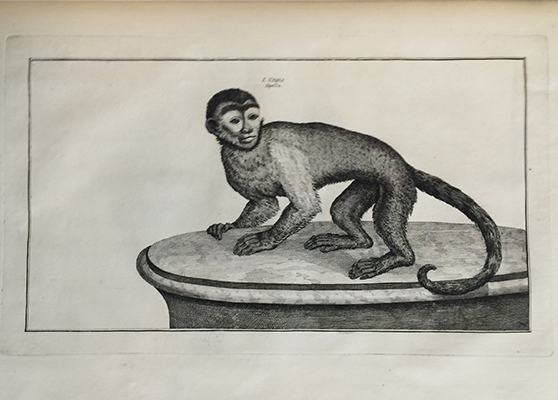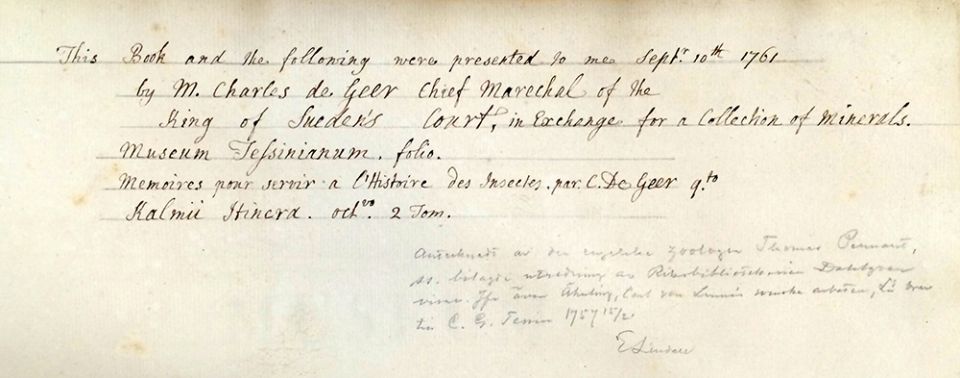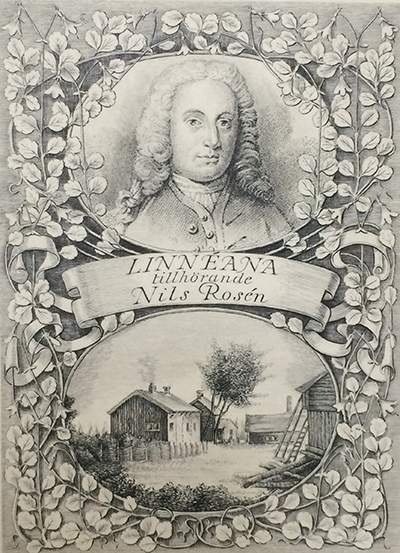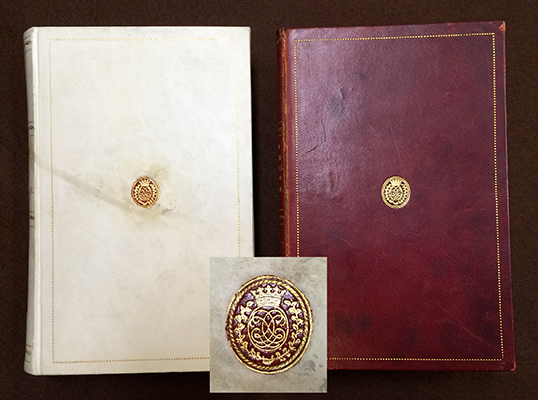Persons, Collections and Topics
Three mid-18th-century catalogs of Swedish natural history collections
Carolus Linnaeus (1707–1778) was a busy man. In the middle of his very full career, while in the process of writing, editing and publishing some of his greatest works, as well as examining specimens, teaching at the University of Uppsala and maintaining an extensive correspondence, he also produced three catalogs of natural history "museums" for other collectors. These described collections of Count Carl Gustav Tessin (1695–1770), King Adolf Fredrik (1710–1771) and Queen Lovisa Ulrika (1720–1782).
While at least one of these collections included plant specimens, plants do not seem to have been their primary emphases, and the rich array of zoological and mineral specimens gave Linnaeus a valuable opportunity to expand what he knew and to add information to his own writings. Although he was not directly involved in developing these collections, he did considerable work in arranging, naming and cataloging the specimens, and material collected by some of his former students who traveled to explore faraway places also found its way into the royal collections. Count Tessin, a friend and patron of Linnaeus, also indirectly contributed to the royal collections, in part by helping to arrange for purchases of specimens at the request of the king and queen. Also, even less directly but quite importantly, Tessin and Magnus Lagerström (1691–1759), director of the Swedish East India Company and a powerful promoter of natural history in Sweden, worked to get naturalists attached to the company's voyages, bringing more exotic specimens back to Sweden (Nynäs and Bergquist 2016, pp. 204–205).
Linnaeana collector Dr. Emil Lindell (1854–1941) had all three of these catalogs (association copies in one way or another) in his book collection, which was acquired and then substantially added to by Dr. Birger Strandell (1901–1993). It was from Dr. Strandell that we purchased our Strandell Collection of Linnaeana in 1968, and many of those books contain both Lindell and Strandell bookplates.
Museum Tessinianum
Museum Tessinianum (Linnaeus 1753) describes specimens from Count Tessin's collection of rocks, minerals, gemstones, fossils, petrifications, shells and some sea animals, such as sponges and starfish. It was published for private circulation as a folio volume of 140 pages and 12 engraved plates in Stockholm in 1753, the same year that Linnaeus also published his landmark botanical work, Species plantarum. The text is in Latin and Swedish in parallel columns, making it readable to many in and beyond Sweden. The plates are unsigned, but most were engraved by Per Gustaf Floding (1731–1791) according to the Milestones of Science Books Web site (https://www.milestone-books.de/pages/books/002748/carl-gustaf-tessin-carl-linnaeus/museum-tessinianum-opera-illustrissimi-comitis-ed-c-linnaeus-carl-gust-tessins-naturalie). Although Linnaeus's name did not appear on the title page, in the preface Tessin highlighted Linnaeus's acumen in examining the collection, arranging it in order and enriching the list of specimens with his observations, and Linnaeus is considered to be the author. In return for his work on the catalog he received "a gold watch and a copy of Rumphius's Herbarium Amboinense, together worth 100 plåter" (Blunt 2001, p. 211), but the true reward would have been the opportunity to examine, arrange and describe the specimens. Tessin gave copies of his catalog to friends and contacts, and our copy is inscribed by him on the front flyleaf: "a Monsieur, Monsieur Balguerie, Agent de Suéde a Amsterdam, de la part de son vrai ami et serviteur, Tessin" (to Mr. Balguerie, Agent from Sweden to Amsterdam, from his true friend and servant, Tessin). Pierre Balguerie (dates unknown) was Swedish Consul at Amsterdam and served as an agent locating and buying natural history specimens for the king and queen and also for Tessin.
Tessin held a series of positions in the Swedish government, serving as speaker of the house of nobles, chancellor, and ambassador to Vienna and later France. For a time he was marshal to the queen's household. He built up his own art and natural history collections and an impressive library. This aristocratic politician and diplomat offered Linnaeus a room in his home and "free fork" at his table, which Linnaeus gratefully availed himself of until his marriage (Blunt 2001, pp. 132–133). Tessin arranged for Linnaeus to be appointed physician to the admiralty, and the two of them enjoyed a strong connection around their shared natural history interests. When the Royal Academy of Sciences was begun, Linnaeus was among its founders and served as its first president (chosen by lottery) while Tessin was its first secretary. Even after Tessin had fallen out of political favor, Linnaeus remained a lifelong friend. So much of Tessin's life and work were wrapped up in Swedish domestic and international politics, and yet he also left a legacy in natural history, not only through his "museum" and its catalog but also in opening his collection to Linnaeus and sharing network opportunities. Tessin dedicated his catalog to Linnaeus, and when Basil Soulsby later described Linnaeus's tenth edition of Systema naturae (1758), he wrote: "In this edition, the binomial system previously employed by Linnaeus in the work entitled Museum Tessinianum (1753) was extended in its application to all the kingdoms of nature ..." (Soulsby 1933, pp. 10–11, no. 58). Linnaeus dedicated that tenth edition to Tessin, and that year Tessin had a medal designed and struck in silver to honor Linnaeus.
The fate of Tessin's mineral collection was more convoluted than that of the royal collections described below. In 1762 he sold what is described as his 13,000-specimen mineral collection to the Danish king, Frederik V, who incorporated it into the royal collection at "Charlottenborgs Natural– og Husholdningskabinet," curated by Peter Ascanius (1723–1803), who taught zoology and mineralogy in Copenhagen. Tessin's collection included some specimens from Anders Philipp Tidström (1723–1779), who cataloged the Tessin collection after it was sold, in preparation for its being sent to Denmark in 1764 (Fihl, pers. comm., 29 October 2021).
The sale of the Tessin collection was arranged by Danish statesman and diplomat Adam Gottlob von Moltke (1710–1792), and a number of Tessin specimens were also added to Moltke's own collection, inherited by his son Joachim Godske von Moltke (1746–1818). The royal collection "Charlottenborgs Natural- og Husholdningskabinet" (1759–1772) was in 1772 incorporated into the "Universitetets Nye Naturaltheater, Konsistoriebygningen" (1770–1810). In 1810 this new University Museum was bought by J. G. Moltke, who incorporated it — together with several other important collections including Tessin's in the former royal collection — into his own, forming the large collection that he donated to the University of Copenhagen, where it was retrospectively named "Grev Moltkes Universitet tilhørende geologisk Museum" (1810–1893). In the following years several more large collections were added, including the royal collection from Danish king and natural history collector Christian VIII (1786–1848). All of these important Danish collections formed the core of the Mineralogical Museum, which opened at Øster Voldgade 5–7 in 1893, known today as the University of Copenhagen's Geological Museum, part of the Natural History Museum of Denmark (Fihl, pers. comm., 4 November 2021).
Museum Adolphi Friderici Regis
In the 18th century the most important and impressive natural history collections in Sweden were those of the king and queen. The catalog of King Adolf Fredrik's collection, Museum S:ae R:ae M:tis Adolphi Friderici Regis (Linnaeus 1754–1764) was published in two volumes separated by a decade. In the preface to volume 1, Linnaeus wrote (later translated by James Edward Smith, 1759–1828):
His Majesty has adorned his splendid museum, in the palace of Ulricsdahl, with a variety of quadrupeds preserved in spirits of wine, a great number of stuffed birds and innumerable quantity of insects and shells arranged in cabinets: not to mention the valuable Herbarium, and the beautiful Menagerie in which living beasts and birds are kept. The Queen has taken delight in collecting insects and shells, as well as corals and crystals, from all parts of the world; and has ornamented her palace of Drottningholm with them so successfully, that I doubt whether any other collection of the kind can be compared to it (Linnaeus 1798, p. 29).
Volume 1 was published in 1754 as a large folio volume of 137 pages with text in Latin and Swedish in parallel columns and 33 engraved plates, mostly illustrating snakes and fishes, along with two monkeys. The mammals were drawn by Lorenz Pasch (1702–1766), the snakes by Olof von Dalin (1708–1763), and some of the fishes by Jean Eric Rehn (1717–1793; Lovén 1887, p. 38); the engraving was done by Jacob Gillberg (1724–1793; Gentry 2008, p. 148). Volume 2 was a small octavo volume of 113 pages, without plates, published as a prodromus in Latin only in 1764 along with a catalog of insects and shells in the queen's collection.
The king began collecting natural history specimens as crown prince, and in 1745 he donated to the University of Uppsala 87 animal specimens preserved in glass bottles filled with wine spirits, an important gift for the instruction of students. A description of many of these (mostly fishes and amphibia) was published the next year in the Linnaean dissertation Museum Adolpho-Fridericianum ... (Stockholm, typis L. Salvii, 1746), defended by Lars Balk filius (1726–1790) and dedicated to the crown prince and crown princess. Information about the royal collections and several other important Swedish collections was also published in other Linnaean dissertations, along with one on how to set up a natural history collection.
Adolf Fredrik became king in 1751, and he continued to buy specimens through foreign traders, often Dutch. His collection, primarily zoological, was kept at Ulriksdal. When the collection of famed Dutch naturalist and collector Albertus Seba (1665–1736) was being offered for sale in 1752, both king and queen tasked Pierre Balguerie with buying specimens for them. More specimens were acquired from North America, China, Palestine, Egypt, Surinam, the Cape of Good Hope and the West Indies (Nynäs and Bergquist 2016, pp. 39–40), including from the voyages of former Linnaeus students. In 1751 Linnaeus was invited to work on arranging the royal collections and then writing descriptions of them, which brought him into frequent contact with both king and queen. He made four visits to Drottningholm in 1751–1752 (spending about 13 weeks there) and three to Ulriksdal in 1753–1754 (about 9 weeks), with additional visits in 1754, 1766 and 1770 (Gentry 2008, p. 148).
He sent the manuscript of volume 1 of the king's catalog to the printer in September 1753, and it was published in 1754. The text of the queen's catalog had mostly been written in 1751–1752, and the manuscript of the king's second volume was also ready, but now complex political undercurrents and machinations came to a boil for the king and queen and "preparations already far advanced were broken off, the artists ceased from their work, and Linnaeus had to consign his manuscripts to a repose that was to last for years" (Lovén 1887, p. 40). From this point Linnaeus ceased to spend much time at the palaces, and for the most part this period in his career ended, save for a few visits in later years. This interruption also caused a significant problem for him because he had been counting on having the two royal catalogs published so that in his own Systema naturae he could refer readers to those catalogs for the full descriptions of many species. He was not free to publish those descriptions in his own works when they had not yet been published in the royal catalogs. For the species that he had cataloged from the queen's collections, he was able to introduce them in Systema naturae only "under final binary denominations, with their 'differentiae' only, but amplified and revised, and with the references to preceding authors" (Lovén 1887, pp. 40–41).
Years passed, and finally in early 1763 he asked for and received the queen's permission to publish privately her partial catalog without plates, in octavo as a prodromus, also receiving permission to publish a second part of the king's catalog as a short prodromus to the second unpublished volume, listing a selection of the most remarkable specimens. These were published together with separate title pages and pagination but continuous registration (set up to be printed together as one book) in 1764. In this way Linnaeus's earlier work on the queen's catalog had, due to circumstances, become the later publication, and with it only an abbreviated part of the king's second volume ever made it into publication (Lovén 1887, pp. 41–44). Information from the 1754 catalog was added to Systema naturae, ed. 10 (1758), and information from the 1764 catalogs was added to the 12th edition (1766; Gentry 2008, p. 148).
The king died in 1771, and in 1773 his museum was moved to Drottningholm and united with the queen's, both collections now owned by their son Gustav III (1746–1792). In 1777 the palace and collections were purchased by the Swedish State, but it was not until 1801 that Gustav IV Adolf (1778–1837) sent his grandfather's bottled collections to the Royal Swedish Academy of Sciences, and the mammals and birds were incorporated into the Swedish Museum of Natural History in 1828 (Harbers 2014, p. 147; Gentry 2008, pp. 146–147). In 1803 he donated his grandmother's collections along with the cabinets that held them to the Museum of the University of Uppsala (Lovén 1887, pp. 44–45). The collections given to the academy are now held at the Swedish Museum of Natural History, and those given to the University of Uppsala are held at The Evolution Museum in Uppsala.
Our copy of volume 1 of the king's catalog has an inscription on the front flyleaf that has been identified as written by Thomas Pennant (1726–1798), referring to books he received from Baron Charles De Geer (1720–1778):
This book and the following were presented to me Sept. 10th 1761
By M. Charles de Geer Chief Marechal of the
King of Sueden's Court, in Exchange for a Collection of Minerals.
Museum Tessinianum. folio.
Memoires pour servir a l'Histoire des Insectes. par C. De Geer, qto.
Kalmii Itinera. octvo. 2 tom.
Pennant was a Welsh naturalist, traveler and antiquarian who published numerous works and conducted an extensive correspondence, including with Linnaeus and De Geer. He had particular interests in fossils, minerals, quadrupeds and birds, and the De Geer books, the Tessin catalog and the travel account of former Linnaean student Pehr Kalm (1716–1779) mentioned in the inscription would have been valuable additions to his library. De Geer was a wealthy businessman and naturalist who successfully took on his uncle's responsibilities at Leufstabruk, where there was an important iron works. He was also one of the great entomologists of his time and had one of the finest natural history libraries in Sweden (Nynäs and Bergquist 2016, p. 468). From a young age he studied insects, and when he began a correspondence with Linnaeus, the two men formed a bond over shared entomological interests. De Geer described 1,446 species of insects, many of which he also illustrated (Clemedson 1978, p. 148).
We hold one copy of volume 1 of the king's catalog and three copies of volume 2 (issued with the queen's catalog), of which two came from Dr. Lindell — one with the bookplate of Nils Rosén (?–1929), the other signed by the German entomologist Philipp Christoph Zeller (1808–1883) — and a third copy in its original grey cover was collected by Dr. Strandell.
Museum Ludovicae Ulricae Reginae
The catalog of the queen's collection, Museum S:ae R:ae M:tis Ludovicae Ulricae Reginae (Linnaeus 1764), was published as a prodromus in Latin without plates, in an octavo volume of 730 pages with title page printed in red and black. The volume 2 Prodromus of the King's catalog follows hers, with separate title page and pagination but continuous registration.
Lovisa Ulrika, sister of King Frederick the Great of Prussia (1712–1786), married Swedish Crown Prince Adolf Fredrik in 1743, a union that Tessin helped to arrange with an eye toward a political alliance with Prussia. In 1744 Tessin escorted her to Stockholm, and soon after her arrival the crown prince gave her Drottningholm Palace (Harbers 2014, pp. 137–138). Her natural history collection there began with one left from her predecessor, Queen Ulrika Eleonora (1688–1741), sister of King Karl XII (1682–1718). Lovisa Ulrika arranged to have additional rooms built, and she greatly enlarged the collection, focusing mostly on insects, shells, corals, ores and crystals from throughout the world. Theodor Magnus Fries (1832–1913) suggested that a bit of a rivalry arose between her and her husband, even though their collecting emphases were different, leading to richer and more valuable collections for both of them (Linnaeus 1906, p. 193). Existing records for palace expenses in 1750–1752 written by Tessin, marshal to the queen's household, show substantial expenditures for natural specimens. When later he fell out of favor and was blamed for such exorbitant spending for such a whimsical purpose, he perhaps "found some solace in recollecting that he had done so, seemingly, to follow the fashion of the day, but in reality just as much for the sake of science and Linnaeus" (Lovén 1887, pp. 6–7).
Linnaeus wrote the preface to the queen's catalog, dated "Hammarby 1764 d. 30 Julie." His treatment of insects filled nearly two-thirds of the work, followed by an account of the queen's worldwide collection of shells, for which he had to devise a more adequate classification than was in his Systema naturae at the time. A third section on starfish and sea urchins was also added, but no corals or minerals were included (Lovén 1887, pp. 43–44). The collections of the king and queen were Linnaeus's most important sources of zoological specimens, and later scientists and scholars have observed their critical importance for his being able to accomplish the work of the tenth edition of Systema naturae, in which he first applied his system of binomial nomenclature to the animal kingdom and substantially revised its classification. The queen's catalog is viewed as one of Linnaeus's major entomological works. She rewarded him with "a fine gold ring set with an oriental ruby ..." (Blunt 2001, p. 213). Again, that compensation would have been secondary to the enormous benefits of being able to work with her collection.
One of Dr. Lindell's copies of the 1764 catalogs was a gift to him from Nils Rosén of Malmö, noted collector of rare books, rare bookplates, letters, autographs, Linnaeana, and gold and silver household items, folk jewelry, coins and medals. Much of Rosén's collection was given to the museum at Malmö, while other items were sold, including Linnaeana. Rosén's Linnaeana bookplate reads "Linnéana tillhörande Nils Rosén" (Linnaeana belonging to Nils Rosén) and shows a portrait of young Linnaeus and a picture of his birthplace. Rosén had these paired catalogs taken apart and rebound as two complementary volumes, one in white and one in red, with identical tooling including a design based on Linnaeus's signet tooled in gold on red leather centered on their front covers. Letters from Rosén and Lindell are laid in, documenting the gift and describing the bindings, which were done by Elsa Ljunggren, who by the age of 19 had her own bookbinding workshop in Skomakaregatan and was highly regarded among booklovers for her artistic work. She died in a railroad crash in 1913, and her beautifully written obituary clipped from Sydsvenska Dagbladet 6 Mars 1913 is also laid in, enclosed in a folded note written by Emil Lindell. The letter from Rosén to Lindell says that he gives these volumes as a gift, not as a purchase, adding: "It is only for the common interest in our great Swedish memory of Linné." The trails of three great natural history collectors, three Linnaeana collectors, writers and subjects of inscriptions and letters left in the volumes by their owners, and a particular bookbinder can all be seen in these three Linnaean catalogs as the volumes were created and passed from hand to hand and shelf to shelf.
Acknowledgments
Thank you to Zina Fihl, Geological Museum (University of Copenhagen), Natural History Museum of Denmark, and to Dan Holtstam, Department of Geosciences, Swedish Museum of Natural History for information on the fate of Count Tessin's mineral specimens. Thank you also to Arne Thorshøj Nielsen and Sten Lennart Jakobsen (1993) from whose article Fihl pulled information to summarize in English the history of the Tessin collection after he sold it.
References
Blunt, W. 2001. Linnaeus, the Compleat Naturalist. Princeton and Oxford: Princeton University Press.
Clemedson, C.-J. 1978. Charles De Geer och Carl von Linné. Svenska Linné-Sällsk. Årsskr. 1972–1974: 146–152.
Gentry, A. 2008. Linnaeus' specimens of mammals and birds. Linnaean, Special Issue No. 8: 145–152.
Harbers, A. 2014. Carl Linnaeus and the natural history collections of Lovisa Ulrika of Sweden at Drottningholm Palace. In: A. M. Gáldy and S. Heudecker, eds. 2014. Collecting Nature. Newcastle upon Tyne: Cambridge Scholars Publishing. Pp. 137–149.
[Linnaeus, C.] 1753. Museum Tessinianum, opera illustrissimi Comitis, Dom. Carl Gust. Tessin. ... Stockholm: Apud Laurentium Salvium.
Linnaeus, C. 1754–1764. Museum S:ae R:ae M:tis Adolphi Friderici Regis ... in quo animalia rariora imprimis, et exotica: Quadrupedia, aves, amphibia, pices, insecta, vermes describuntur et determinantur ... a Car. Linnaeo; ... tomi secundi prodromus. 2 vols. Stockholm: E Typographia Regia Direct. Pet. Momma (vol. 1) and Literis & impensis Direct. Laur. Salvii (vol. 2).
Linneaus, C. 1764. Museum S:ae R:ae M:tis Ludovicae Ulricae Reginae, ... in quo animalia rariora, exotica, imprimis insecta & conchilia describuntur & determinatur, prodromi instar editum a Carolo v. Linné. Stockholm: Literis & impensis Direct. Laur. Salvii.
Linnaeus, C. 1798. Reflections on the study of nature. In: J. E. Smith. 1798. Tracts Relating to Natural History. London: Printed for the author, by J. Davis. ... Pp. 1–46.
Linnaeus, C. 1906. Naturaliesamlingars Andamål och Nytta: Företal till Arbetet Konung Adolf Frideriks Naturalie-samling. In: T. M. Fries, ed. 1905–1913. Skrifter af Carl von Linné. 5 vols. Upsala: Almqvist & Wiksell. Vol. 2. Pp. 177–193.
Lovén, S. 1887. On the species of Echinoidea described by Linnaeus in his work, Museum Ludovicae Ulricae. Bihang till Kongl. Svenska Vetenskaps-Akademiens Handlingar, Bandet 13. 4(5): 1–185.
Nielsen, A. T. and S. L. Jakobsen. 1993. Original nr. MGUH 8736: Entomolithus paradoxus Linné, 1753. In: O. Johnsen, ed. 1993. Geologisk Museum - 100 år på Østervold. Copenhagen: Rhodos. Pp. 26–28.
Nynäs, C. and L. Bergquist. 2016. A Linnaean Kaleidoscope: Linnaeus and His 186 Dissertations. Stockholm: The Hagströmer Medico-Historical Library, Fri Tanke. [Hagströmerbibliotekets Skriftserie 21.]
Soulsby, B. 1933. A Catalogue of the Works of Linnaeus ... ed. 2. London: Printed by Order of the Trustees of the British Museum.
Other resources
On 1 June 1973 the Institute opened the Strandell Room, which houses the Strandell Collection of Linnaeana, and held on 2–3 June the Linnaean Symposium. A Linnaean Keepsake was published to commemorate the event. Also issued were the symposium invitation, symposium program and banquet menu and program.
Nitrum ... Crystallus montana, engraving by an unknown engraver after an original by an unknown artist for Carolus Linnaeus (1707–1778), Museum Tessinianum ... (Stockholm, Apud Laurentium Salvium, 1753, pl. 1), Strandell Collection of Linnaeana no. 5562, HI Library call no. hBD7 T341m STR.
